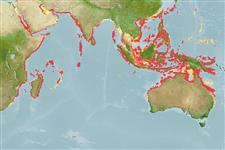>
Mulliformes (Goatfishes) >
Mullidae (Goatfishes)
Etymology: Parupeneus: Latin, parum, parvum = small + Peneus, the name of a river.
More on author: Lacepède.
Environment: milieu / climate zone / depth range / distribution range
Ecologie
marien rifbewoner; diepte 3 - 40 m (Ref. 90102). Tropical; 30°N - 31°S, 30°E - 154°E
Indo-West Pacific: Red Sea and Persian Gulf south to Natal, South Africa extending east to Indonesia and the Philippines. Record from Hawaiii is an error.
Lengte bij maturiteit / Grootte / Gewicht / Leeftijd
Maturity: Lm 12.3 range ? - ? cm
Max length : 40.0 cm TL mannelijk / geslacht onbekend; (Ref. 30874); common length : 20.0 cm TL mannelijk / geslacht onbekend; (Ref. 9947)
Dorsale stekels (totaal) : 8; Dorsale zachte stralen (totaal) : 9; Anale stekels: 1; Anale zachte stralen: 7. Diagnosis: Pectoral rays 15-17 (usually 16). Gill rakers 7-9 + 27-30 (total 34-39). Body moderately elongate, the depth 3.3-3.7 in SL; head length (HL) 2.8-3.2 in SL; snout length 1.7-1.9 in HL; barbels long, their length 1.1-1.25 in HL; longest dorsal spine 1.45-1.75 in HL; penultimate ray of second dorsal fin of adults 1.25-1.6 in last dorsal ray, the last ray relatively longer with growth; pectoral fins 1.3-1.5 in HL; pelvic fins 1.2-1.45 in HL. Body gray to grayish red dorsally, whitish to pink ventrally, with a black stripe from eye along lateral line to anterior part of caudal peduncle; a roundish black spot larger than eye on side of peduncle about two-thirds above lateral line; a broad white zone extending anterior to peduncular spot to below posterior part of second dorsal fin; a vertical pale blue line or spot often present on scales below black stripe; a dusky band often present on snout from eye to side of upper lip; barbels white; first dorsal and caudal fins reddish gray; basal one-third to one-half of second dorsal fin black, the dark pigment continuing to end of last ray and adjacent membrane; outer part of fin with narrow pale blue and yellow stripes; anal fin dusky yellow with faint narrow pale blue stripes (Ref. 54393).
Pale area at end of black stripe and dusky basal stripe in second dorsal fin distinguished it from the similar P. barberinus (Ref. 48636).
Inhabits lagoon and seaward reefs to over 25 m (Ref. 9710). Found on sandy or weedy bottoms (Ref. 30573); rarely at depths of more than 40 meters (Ref. 54393). Usually seen solitary but often several individuals nearby (Ref. 48636). Feeds mainly on crustaceans and worms (Ref. 54393).
Levenscyclus en paargedrag
Maturities | Voortplanting | Spawnings | Egg(s) | Fecundities | Larven
Randall, J.E., 2004. Revision of the goatfish genus Parupeneus (Perciformes: Mullidae), with descriptions of two new species. Indo-Pac. Fish. (36):64 p. (Ref. 54393)
Status op de Rode Lijst van het IUCN (Ref. 130435)
Gevaar voor de mens
Harmless
Gebruik door de mens
Visserij: commercieel; Aquarium: Commercieel
Tools
Speciale rapporten
Download XML
Internetbronnen
Estimates based on models
Preferred temperature (Ref.
123201): 25.6 - 29.1, mean 28 °C (based on 870 cells).
Fylogenetische diversiteitsindex (Ref.
82804): PD
50 = 0.5000 [Uniqueness, from 0.5 = low to 2.0 = high].
Bayesian length-weight: a=0.00912 (0.00570 - 0.01458), b=3.15 (3.02 - 3.28), in cm total length, based on LWR estimates for this species & Genus-body shape (Ref.
93245).
Trofisch niveau (Ref.
69278): 3.5 ±0.41 se; based on food items.
Weerstandsvermogen (Ref.
120179): Gemiddeld, minimale populatieverdubbelingstijd 1,4-4,4 jaar (Preliminary K or Fecundity.).
Fishing Vulnerability (Ref.
59153): Low to moderate vulnerability (30 of 100).
Nutrients (Ref.
124155): Calcium = 31.6 [15.9, 70.8] mg/100g; Iron = 0.298 [0.151, 0.666] mg/100g; Protein = 17.9 [14.5, 20.9] %; Omega3 = 0.116 [0.066, 0.212] g/100g; Selenium = 50.4 [24.6, 111.4] μg/100g; VitaminA = 191 [37, 789] μg/100g; Zinc = 0.526 [0.315, 0.997] mg/100g (wet weight);
